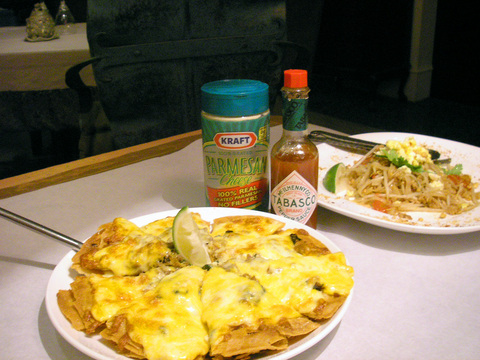Luk Kreung means mixed-blood in Thai, and refers both to mixed ethnicity of restaurant owner Tseng Hsu-min (曾旭民), as well as the mixed parentage of the cuisine that he presents — an innovative combination of Italian and Thai.
When living in Thailand, Tseng, 36, said he frequented a restaurant that cooked Italian food in a Thai style. He believed that this combination would prove popular in Taiwan as well, so two years ago he opened Luk Kreung in Taipei's trendy East District.
On its Chinese-English menu, there is an image of the Virgin Mary, representing Italian food, and one of the Buddha, representing Thai food. These are combined to create his “mixed blood” cuisine.

PHOTO: GINGER YANG, TAIPEI TIMES
This leads to some interesting combinations. There is da-pao pork, a dish of thinly sliced boiled pork with various garnishes, which is a regular feature at many Indo-Chinese themed restaurants. But in this case, it is served on a cornmeal pizza crust (NT$250), with the addition of minced meat and basil. Restaurant manager, Lai Chien-an (賴建安) said it was especially popular as a take out order.
Italian-style fried rice noodles (NT$220) uses anchovies to enhance the flavor of the traditional Thai dish, and can be fine tuned to individual tastes with sugar, ground peanuts and lemon, which are served on the side of the plate. The deep fried trout with Thai apple dressing (NT$480) and grilled beef tenderloin in green curry sauce (NT$700) are worth trying.
Luk Kreung mixes it up with the decor as well; half decorated in palatial Italian style and the other half featuring Thai-themed furniture. The furnishings are uniformly both comfortable and stylish. In fact, the establishment could easily be mistaken for a high-class furniture shop if you don't look too carefully.
There are two rooms for private functions that seat up to 12 people.
The setting is much more luxurious than you would expect for the menu's price range. “We spent more than six months designing the menu and settings. We let our imaginations run wild. Running this restaurant isn't work, it's play,” Lai said. Service is stylish, but not particularly efficient.
After the kitchen closes, Luk Kreung transforms itself into a lounge bar that serves a wide range of spirits and wine. If you want to reserve a seat, call after 5 pm.

In the March 9 edition of the Taipei Times a piece by Ninon Godefroy ran with the headine “The quiet, gentle rhythm of Taiwan.” It started with the line “Taiwan is a small, humble place. There is no Eiffel Tower, no pyramids — no singular attraction that draws the world’s attention.” I laughed out loud at that. This was out of no disrespect for the author or the piece, which made some interesting analogies and good points about how both Din Tai Fung’s and Taiwan Semiconductor Manufacturing Co’s (TSMC, 台積電) meticulous attention to detail and quality are not quite up to

April 21 to April 27 Hsieh Er’s (謝娥) political fortunes were rising fast after she got out of jail and joined the Chinese Nationalist Party (KMT) in December 1945. Not only did she hold key positions in various committees, she was elected the only woman on the Taipei City Council and headed to Nanjing in 1946 as the sole Taiwanese female representative to the National Constituent Assembly. With the support of first lady Soong May-ling (宋美齡), she started the Taipei Women’s Association and Taiwan Provincial Women’s Association, where she

It is one of the more remarkable facts of Taiwan history that it was never occupied or claimed by any of the numerous kingdoms of southern China — Han or otherwise — that lay just across the water from it. None of their brilliant ministers ever discovered that Taiwan was a “core interest” of the state whose annexation was “inevitable.” As Paul Kua notes in an excellent monograph laying out how the Portuguese gave Taiwan the name “Formosa,” the first Europeans to express an interest in occupying Taiwan were the Spanish. Tonio Andrade in his seminal work, How Taiwan Became Chinese,

Mongolian influencer Anudari Daarya looks effortlessly glamorous and carefree in her social media posts — but the classically trained pianist’s road to acceptance as a transgender artist has been anything but easy. She is one of a growing number of Mongolian LGBTQ youth challenging stereotypes and fighting for acceptance through media representation in the socially conservative country. LGBTQ Mongolians often hide their identities from their employers and colleagues for fear of discrimination, with a survey by the non-profit LGBT Centre Mongolia showing that only 20 percent of people felt comfortable coming out at work. Daarya, 25, said she has faced discrimination since she